Centauri Dreams
Imagining and Planning Interstellar Exploration
Enhancing Our View of Europa
Space exploration has been filled with its share of frustrations, the most obvious being the lack of follow-up with travel to the Moon following Apollo 17. That’s been a 50-year gap and counting, but a gap of half that size is also unsettling. It was in late 1995 that the Galileo probe began orbital operations at Jupiter, and since then we’ve had to rely on its imagery of Europa when we needed close up views of the ocean-filled moon. While we await Europa Clipper, scheduled for 2024 launch, and Jupiter Icy Moon Explorer (JUICE), slated by ESA for a departure in 2022, we’re still refining Galileo images in preparation for future flybys.
One thing the newly touched up images should remind us of is that Europa Clipper is going to give us views of much larger parts of Europa’s surface at high resolution, complementing but considerably extending what Galileo was able to do. The latter was a mission with its own set of frustrations, of course, as a recollection of its unusable high gain antenna makes clear, but the superb work by ground controllers in recovering these Europa images is an object lesson in getting the most out of the equipment you’ve got left. Let’s hope Europa Clipper runs into no comparable difficulties.

Image: This image shows a transitional location between blocky chaos terrain, on the left, and ridged plains on the right. A few chaos blocks are visible on the left as individually broken and rotated pieces of preexisting surface material; their shadows indicate that some of these blocks have tilted as well. A ridge passes through the center of this image. These ridges, which contain arc-shaped segments joined together by a series of cusps, may be related to how the icy surface crust of Europa fractures when subjected to stresses from Jupiter’s strong gravity. The right side of this image shows a few lenticulae, which are small rounded surface features, commonly domed in appearance. The image resolution is 247 yards (226 meters per pixel, and this image depicts an area about 180 miles (300 kilometers) across. Credit: Mario Valenti / SETI Institute / NASA/JPL-Caltech.
The three images here were captured on the eighth of Galileo’s targeted flybys, showing features as small as 460 meters in size. They were taken through a clear filter in grayscale, with lower-resolution images from the same region on a different flyby used to map color onto the grayscale, producing, at a cost of considerable time and processing power, what we see here. These are enhanced-color images, thus exaggerating color variations to bring out the chemical composition of the surface. The light blue or white areas are predominantly water ice, while reddish areas are laden with other materials, like salts.

Image: This image shows a region of Europa’s surface covered with ridges and bands, with a few small disrupted chaos regions. Ridges, a common surface feature type, may form when a crack in the surface opens and closes repeatedly, building up a feature that’s typically a few hundred yards tall, a few miles wide and that can stretch horizontally for thousands of miles. In contrast, bands are locations where a crack appears to have continued pulling apart horizontally, producing large, wide, relatively flat features. This image shows both ridges and bands, which interact with each other in complex ways that are somewhat similar to tectonic activity on the Earth. Credit: NASA/JPL-Caltech/SETI Institute.
All three images were captured in the spacecraft’s 17th orbit of Jupiter (E17), with the lower-resolution color images used for mapping taken in orbit E14. The striking thing about the Europan surface has always been its relative youth, some 40 to 90 million years old, meaning what we see is much younger than the moon itself, which would have formed 4.6 billion years ago. This is one of the youngest surfaces in the Solar System, a place of long linear ridges and bands that indicate crustal stretching under the influence of Jupiter’s strong gravity.

Image: A region of blocky chaos terrain, where the surface has broken apart into many smaller chaos blocks that are surrounded by featureless matrix material. Many of the chaos blocks have moved sideways, rotated, or tilted before being refrozen into their new locations, and some larger blocks preserve features of the pre-existing terrain before it was broken up. Using these features as clues, scientists have been able to reconstruct some chaos regions like jjgsaw puzzles to track the motion of blocks. Cutting through the chaos terrain near the bottom, from left to right, is a broad flat band. Called Agenor Linea, it is one of the longest bands on Europa and is distinctive for its two-color appearance, with a bright region at the top and a darker region below. Another rare bright band, Katreus Linea, cuts across the top portion of this image. The image resolution is 243 yards (222 meters) per pixel, and this image depicts an area about 170 miles (280 kilometers) across. Credit: NASA/JPL-Caltech/SETI Institute.
Europa Clipper will conduct numerous flybys of Europa as we try to learn more about the ocean now believed to exist beneath the icy crust, and its interactions with the surface. The disrupted areas known as ‘chaos terrain’ are particularly interesting, as they show blocks of surface material that have been moved through gravitational stresses and then refrozen into a new location. The jigsaw puzzle analogy JPL uses to describe them is exactly on target.
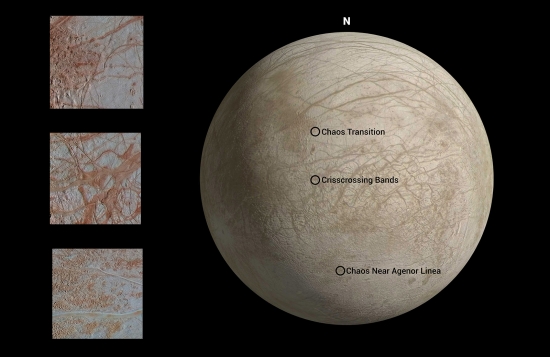
Image: The locations on Europa depicted in the newly processed images, with Chaos Transition at top. This image is centered approximately at 6.4 degrees north latitude, and 135.3 degrees east positive longitude. Credit: NASA/JPL-Caltech/SETI Institute.
Original plans for a Europa orbiter were scrapped at least partly due to concerns over the radiation levels produced by Jupiter’s magnetosphere. Instead, we’ll get over 40 close flybys as Europa Clipper makes its way around the giant planet in an elliptical orbit. The JUICE mission will conduct two Europa flybys of its own, while adding multiple flybys of Callisto before settling into orbit around Ganymede. By the end of this decade, then, we should start updating these spectacular images with high-resolution views of entirely new terrain, and the long wait for a return to Europa will finally end.

Limitless Space Institute Establishing Research Grants
Harold “Sonny” White’s investigations into controversial concepts like EMdrive and Alcubierre warp drive physics at Eagleworks Laboratories (located at the Johnson Space Center in Houston) received a good deal of attention in the interstellar community. In a recent email, Dr. White told me that he left NASA in December of 2019 and is now affiliated with the Limitless Space Institute, serving as its Director of Advanced Research and Development. The recently launched LSI is creating a series of initiative grants in support of interstellar research. What follows is the news release LSI has just released.
Limitless Space Institute announces biennial Interstellar Initiative Grants (I2 Grants)
Limitless Space Institute is launching biennial research grants with the goal of providing measurable and consistent support for pursuing interstellar research called Interstellar Initiative Grants. This call for proposals is seeking to support grants that can be categorized as either a tactical grant (?$100k) or a strategic grant (?$250k), with the former focused on research papers and the latter on laboratory testing. The anticipated period of performance for the grants is expected to be ~12-14 months in duration, with a start date by the end of September 2020. It is LSI’s vision that by establishing the Interstellar Initiative Grants, and by conducting these grant awards on a biennial cycle, LSI will help grow and mature the capabilities of the interstellar research community. For more information, see https://www.limitlessspace.org/
Email Contact: jan@limitlessspace.org
About LSI
Limitless Space Institute is a non-profit organization whose mission is to inspire and educate the next generation to travel beyond our solar system and to research and develop enabling technologies. LSI advances the pursuit of relevant deep space exploration R&D through the following three approaches:
• Internal R&D: pursuing in-house basic research at the Eagleworks Laboratories near Johnson Space Center.
• External R&D: directly funding selected R&D projects through I2 Grants.
• Collaborative R&D: advancing research in collaboration with university partners.
LSI was founded by Dr. Kam Ghaffarian, previously founder of the award-winning contractor Stinger Ghaffarian Technologies and recognized by Ernst & Young as Entrepreneur of the Year. LSI’s president is Brian “BK” Kelly, who served with NASA for 37 years, most recently as Director of Flight Operations, responsible for selecting astronauts and planning and implementing human spaceflight missions. Dr. Harold “Sonny” White leads LSI’s Advanced R&D, bringing decades of research experience in the advanced power and propulsion domain, most recently serving as the NASA Johnson Space Center Engineering Directorate’s Advanced Propulsion Theme Lead.
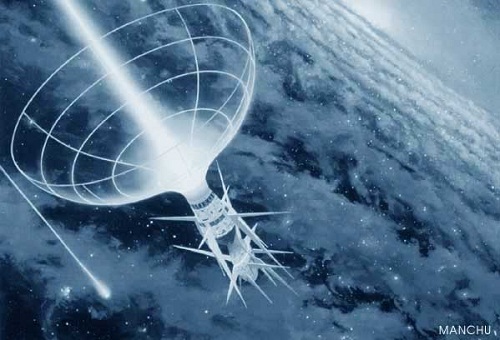
Image: A Bussard ramjet in flight, as imagined for ESA’s Innovative Technologies from Science Fiction project. Credit: ESA/Manchu.

Kepler-88’s Planetary Dance Grows More Complicated
Transit timing variations are useful to astronomers trying to learn what forces are acting upon a known exoplanet. They could eventually help us ferret out the existence of a sufficiently large moon, for example, though we have yet to confirm one. But they also show us how much impact other planets in the same system can have upon the planet being observed.
All this is why the Kepler-88 system has been high on the list of interesting targets for astronomers. Before the recent discovery of a new gas giant, we knew about Kepler-88 b and c, one of them (the outer world Kepler-88 c) about 20 times more massive than Kepler-88 b, a planet less massive than Neptune. The story here was the mean motion resonance, in which planet c, a Jupiter-mass world, orbits the star in 22 days while Kepler-88 b orbits in 11: Two orbits of b in the time it takes c to make a single orbit. Planet b is the only transiting planet in this system; Kepler-88 c was confirmed by radial velocity methods.
The mass differential is telling, so that the more massive Kepler-88 c causes notable transit timing variations in Kepler-88 b. In fact, the Kepler mission was able to detect TTVs of up to half a day forced by Kepler-88 c. These are to my knowledge the largest transit timing variations yet observed. All of that makes the system interesting in its own right, but now we have word of another planet here, Kepler-88 d, which turns out to be about three Jupiter masses.
The radial velocity discovery, which also confirmed the existence, mass and orbital period of Kepler-88 c, was made by a team led by Lauren Weiss (University of Hawaii Institute for Astronomy), using the High-Resolution Echelle Spectrometer (HIRES) instrument on the 10-meter Keck I telescope in Hawaii. The discovery paper appears in The Astronomical Journal.
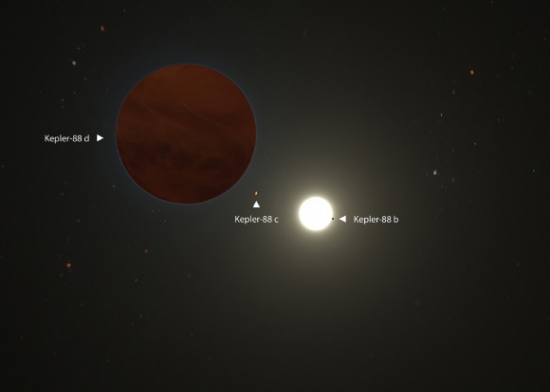
Image: An artist’s illustration of the Kepler-88 planetary system. Credit: W. M. Keck Observatory / Adam Makarenko.
“At three times the mass of Jupiter, Kepler-88 d has likely been even more influential in the history of the Kepler-88 system than the so-called king, Kepler-88 c, which is only one Jupiter mass,” says Weiss. That influence is a reference to the effects of a gas giant in a Jupiter-like orbit (the planet is in an elliptical orbit around Kepler-88 with a period of four years). Jupiter is assumed to have affected cometary orbits in the early days of the Solar System, drawing materials rich in volatiles into the inner system where they would have been part of the mechanism for producing oceans on Earth.
But this is a stellar system that will have a much different fate than our own. The host star Kepler-88 is a massive B-class object, highly luminous and with a lifetime lasting only in the low millions of years. No habitable zone worlds to nourish with oceans or, at least, no such worlds with a billion-year timeframe for life to flourish.
ADDENDUM See andy’s comment below, and also Mike Fidler’s — the B-class statement in the paragraph above is is incorrect, and the result of discrepancies between the sources. It looks as though this is a G-class object and I’m trying to confirm that.
Later: I’m going with andy’s assessment — this is a G-class star, as given by the paper’s data on it: 5466 K, 0.985 solar masses and 0.900 solar radii. Other sources also peg it as a G, so I think we have to assume that the B-class identification that appears in some online sources is incorrect.
Even so, it’s friendly to planet formation. According to the paper, finding multiple giant planets is not surprising, because of the high metallicity of the star. The paper goes on to speculate about planet formation and the likelihood of early migration:
Since both planets c and d are gas giants, they must have formed early in the disk lifetime, when gas was abundant… Perhaps additional giant planets were present earlier, or are still present. Planets c and d likely underwent viscous (Type I) migration in the proto-planetary disk. As the gas disk dissipated, planet-planet scattering would likely have increased, and low and high-eccentricity migration likely became important at this time. The high eccentricity of planet d probably arose due to a significant exchange of angular momentum with another gas-giant planet.
The smaller Kepler-88 b, then, may have formed when gas was less abundant in the early disk, and the authors believe that the world could have been caught in its current mean motion resonance with Kepler-88 c during the period of early inward migration of planet c.
The paper is Weiss et al., “The Discovery of the Long-Period, Eccentric Planet Kepler-88 d and System Characterization with Radial Velocities and Photodynamical Analysis,” Astronomical Journal Vol. 159, No. 5 (29 April 2020). Abstract / Preprint.

Exoplanet Atmospheres: Recalibrating Our Models
We may be measuring planetary temperatures with less than optimum tools. Calling it a “new phenomenon,” Cornell University’s Nikole Lewis described the background of a just published paper looking into hot Jupiter temperatures. Lewis had been increasingly puzzled by earlier work on the matter, which produced temperatures colder than scientists expected. The deputy director of the Carl Sagan Institute, Lewis joined colleagues Ryan MacDonald and Jayesh Goyal in looking for the reason, reporting their results in Astrophysical Journal Letters.
What emerged was the need to fine-tune our analysis of exoplanet atmospheres, as delivered by the technique called transmission spectroscopy, in which the light of a parent star is filtered through a planetary atmosphere during a transit. Have a look, for example, at an illustration of the hot-Jupiter WASP-43b as it transits its star. Scientists have been able to construct temperature maps for the planet as well as probing its atmosphere to understand the molecular chemistry within. But the data on atmospheric composition have to be interpreted correctly.
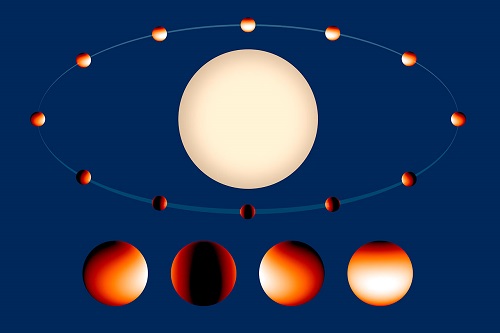
Image: In this artist’s illustration the Jupiter-sized planet WASP-43b orbits its parent star with a year lasting just 19 hours. The planet is tidally locked, meaning it keeps one hemisphere facing the star, just as the Moon keeps one face toward Earth. The color scale on the planet represents the temperature across its atmosphere. This is based on data from a 2014 study (not the Lewis paper) that mapped the temperature of WASP-43b in more detail than had been done for any other exoplanet at that time. Credit: NASA, ESA, and Z. Levay (STScI).
Hot Jupiters orbit close enough to their star to become tidally locked, while the intense gravitational forces at work can cause the planet to bulge, making it egg-shaped. What we would expect is a wide range of temperatures, varying by thousands of degrees, between the blistering ‘day’ side of the star and the frigid side turned away from the star. Averaging temperatures like these can be a problem, according to the Cornell researchers, and the range of temperatures likewise can promote entirely different chemistry between the two sides.
“When you treat a planet in only one dimension, you see a planet’s properties – such as temperature – incorrectly,” Lewis said. “You end up with biases. We knew the 1,000-degree differences were not correct, but we didn’t have a better tool. Now, we do.”
Let’s dig into this. We have over 40 examples of hot Jupiters with transmission spectra, meaning that the science of exoplanet atmospheres is becoming established — eventually, we’ll drill down to smaller rocky worlds to learn about possible biosignatures, but for now, we’re detecting various atoms and molecules in the atmospheres of close-in gas giants. Observations of high enough precision can use transmission spectroscopy to learn about temperatures at the terminator, the zone where day meets night and the temperature contrast can be huge.
Both optical and near-infrared data are needed to draw accurate conclusions. The anomaly that the authors are addressing is that almost all of the retrieved temperatures for hot Jupiters are cooler than planetary equilibrium temperatures derived for the planet. In fact, the retrieved temperatures for most hot Jupiters are between 200 and 600 K cooler than the equilibrium temperature ought to be. The equilibrium temperature is the point at which the planet emits as much thermal energy as it receives from the star. It is commonly denoted as Teq.
The authors propose that the colder temperatures being found via transmission spectra are the result of the use of 1-dimensional models. The atmosphere at the terminator is more complex than the 1D model can show. They call for more complex 3D general circulation models (GCM) to replace them. Sets of differential equations are put to work in a GCM, with the planet divided into a 3-dimensional grid and analyzed in terms of winds, heat transfer, radiation and other factors, taking into account their interactions with other parts of the grid. The difference is striking, as the image below, drawn from the paper, demonstrates.
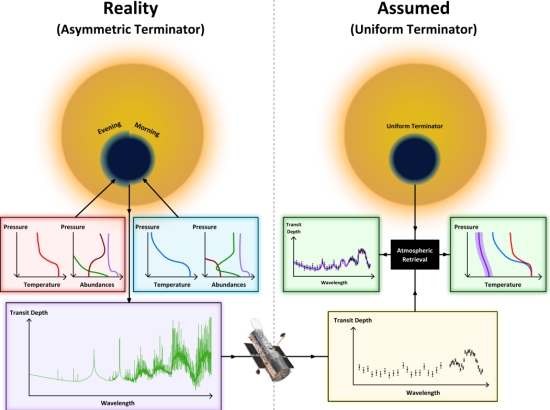
Image: This is Figure 1 from the paper. Caption: Schematic explanation of the cold retrieved temperatures of exoplanet terminators. Left: a transiting exoplanet with a morning-evening temperature difference (observer’s perspective). Differing temperature and abundance profiles encode into the planet’s transmission spectrum. Right: the observed spectrum is analysed by retrieval techniques assuming a uniform terminator. The retrieved 1D temperature profile required to fit the observations is biased to colder temperatures. Credit: MacDonald et al.
Thus the earlier models bias the results toward colder temperatures. And this can be significant in our evaluation of planetary atmospheres, as the paper notes:
Those [chemical] species exhibiting compositional differences have retrieved 1D abundances biased lower than the true terminator-averaged values. Even species uniform around the terminator (here, H2O) are biased, though to higher abundances. Compositional biases become more severe as the retrieved P-T profile deviates further from the true terminator temperature. In the most extreme case, the retrieved H2O abundance is biased by over an order of magnitude, such that one would incorrectly believe a solar-metallicity atmosphere was 15 × super-solar at > 3σ confidence.
We need to resolve this matter, then, to conduct more accurate atmospheric work. The paper continues:
The retrieved cold temperatures of exoplanet terminators in the literature can be explained by inhomogenous morning-evening terminator compositions. The inferred temperatures arise from retrievals assuming uniform terminator properties. We have demonstrated analytically that the transit depth of a planet with different morning and evening terminator compositions, when equated to a 1D transit depth, results in a substantially colder temperature than the true average terminator temperature. This also holds for state-of-the-art retrieval codes, with the added complication that retrieved chemical abundances can also be significantly biased.
Using the older models has meant that the temperatures of hot Jupiters thus far measured may be biased by hundreds of degrees below their true value. The figure reaches 1000 K in the case of ultra-hot Jupiters. An implication here is that the chemistry derived from the older models is less reliable. The authors call for the use of more sophisticated retrieval tools, acknowledging the increased computer overhead involved with 3D approaches but arguing that such models will produce more accurate data on atmospheric temperatures and composition.
The paper is MacDonald et al., “Why Is it So Cold in Here? Explaining the Cold Temperatures Retrieved from Transmission Spectra of Exoplanet Atmospheres,” Astrophysical Journal Letters Vol. 893, No. 2 (23 April 2020). Abstract / preprint.

Into the Magellanics
Somehow it feels as if the Hubble Space Telescope has been with us longer than the 30 years now being celebrated. But it was, in fact, on April 24, 1990 that the instrument was launched aboard the space shuttle Discovery, being deployed the following day. 1.4 million observations have followed, with data used to write more than 17,000 peer-reviewed papers. It’s safe to say that Hubble’s legacy will involve decades of research going forward as its archives are tapped by future researchers. That’s good reason to celebrate with a 30th anniversary image.
I’m reminded that the recent work we looked at on the interstellar comet 2I/Borisov involved Hubble as part of the effort that detected the highest levels of carbon monoxide ever seen in a comet so close to the Sun. Using Hubble data is simply a given wherever feasible. And given yesterday’s article on star formation and conditions in the Sun’s birth cluster that may have produced leftover material from other stellar systems still orbiting our star, it’s worth noting the portrait Hubble just took of two extraordinary nebulae that are part of a star-formation complex.
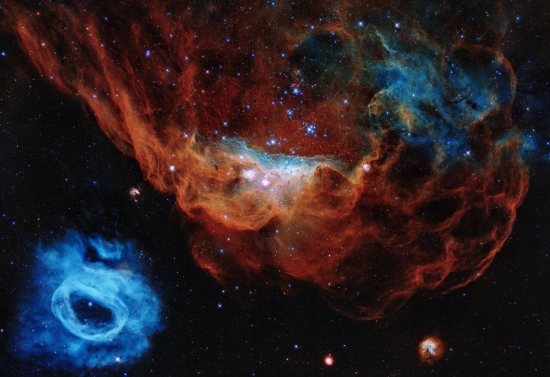
Image: This image is one of the most photogenic examples of the many turbulent stellar nurseries the NASA/ESA Hubble Space Telescope has observed during its 30-year lifetime. The portrait features the giant nebula NGC 2014 and its neighbor NGC 2020 which together form part of a vast star-forming region in the Large Magellanic Cloud, a satellite galaxy of the Milky Way, approximately 163,000 light-years away. Credit: NASA, ESA, and STScI.
Here we’re deep in the Large Magellanic Cloud. This is a visible-light image showing NGC 2014 and NGC 2020, which although appearing separate here, are part of a large star-forming region filled with stars much more massive than the Sun, many of them with lifetimes of little more than a few million years. Dominating the image, a group of stars at the center of NGC 2014 has shed the hydrogen gas and dust of stellar birth (shown in red) so that the star cluster lights up nearby regions in ultraviolet while sculpting and eroding the gas cloud above and to the right of the young stars. Bubble-like structures within the gas churn with the debris of starbirth.
At the left, NGC 2020 is dominated by a star 200,000 times more luminous than the Sun, a Wolf-Rayet star 15 times more massive than our own. Here the stellar winds have again cleared out the area near the star. According to the ESA/Hubble Information Center, the blue color of the nebula is oxygen gas being heated to 11,000 degrees Celsius, far hotter than the surrounding hydrogen gas. We should keep in mind when seeing such spectacular imagery that massive stars of this kind are relatively uncommon, but the processes at work in this image show how strong a role their stellar winds and supernovae explosions play in shaping the cosmos.
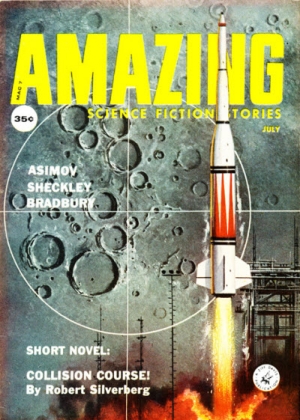
Inevitably I’m reminded of science fictional treatments of the Magellanics, especially Olaf Stapledon’s Star Maker (1937), in which a symbiotic race living in the Large Magellanic Cloud (LMC) is the most advanced life form in the galaxy. But let’s also remember that when Arthur C. Clarke’s starship leaves the Sun in Rendezvous with Rama (1973), it’s headed for the LMC. Among scores of other references, from Haldeman’s The Forever War to Blish’s Cities in Flight, I’m particularly fond of Robert Silverberg’s less known Collision Course, probably because a shorter version fired my imagination as a boy in a copy of Amazing Stories I still possess.
Image: The brilliant Cele Goldsmith was editing Amazing Stories by the time the July, 1959 issue containing “Collision Course” came out. The full novel would be published in 1961.
There is something about what you would see in the night sky from a satellite galaxy, as opposed to our own view of the Milky Way from within its disk, that fires the imagination. For an entirely different view of the galaxy, read Poul Anderson’s World Without Stars (1966), as discussed in these pages back in 2014 in The Milky Way from a Distance.

Identifying Asteroids from Other Stars
Objects of interstellar origin in our own Solar System continue to draw attention. Comets from other stars like 2I/Borisov give us the chance to delve into the composition of different stellar systems, while the odd ‘Oumuamua still puzzles astronomers. Comet? Asteroid?
Now we have a paper from Fathi Namouni (Observatoire de la Côte d’Azur, France) and Maria Helena Morais (Universidade Estadual Paulista, Brazil) targeting what the duo believe to be a population of asteroids captured from other stars in the distant past. Published in Monthly Notices of the Royal Astronomical Society, the paper relies on a high-resolution statistical search for stable orbits, ‘unwinding’ these orbits back in time to explain the location of certain Centaurs, asteroids moving perpendicular to the orbital plane of the planets and other asteroids.
Centaurs, most of which do not occupy such extreme positions, are a population of asteroids moving between the outer planets in what have until now been considered unstable orbits. The ones Namouni and Morais focus on are not recent interstellar ‘interlopers’ like ‘Oumuamua and Borisov, but objects that may have been drawn into the Sun’s gravitational pull at a time when the Solar System was still in formation, some 4.5 billion years ago. In those days, the Sun would have been part of a star cluster, with many young stars in close proximity. The authors believe they can identify 19 asteroids that once orbited other stars and now orbit the Sun.
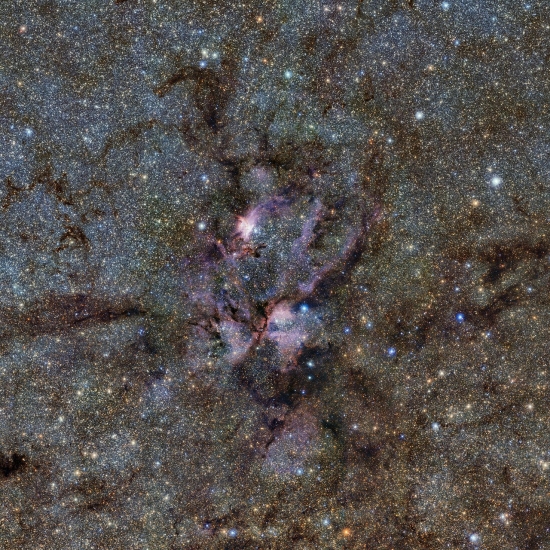
Image: A stellar nursery in the Lobster Nebula (NGC6357), where star systems exchange asteroids as our Solar System is thought to have done 4.5 billion years ago. Credit: ESO / VVV Survey / D. Minniti. Acknowledgement: Ignacio Toledo (CC BY 4.0).
The authors delve into the dynamical evolution of Centaurs through statistical searches for stable orbits, to find out whether any could have survived from the days of the Solar System’s formation. In 2018, Namouni and Morais produced a paper using these methods that led to the identification of a retrograde co-orbital asteroid of Jupiter called (514107) Ka‘epaoka‘awela as an object of likely interstellar origin. The new study extends their simulations to the past orbits of 17 high-inclination Centaurs and two trans-Neptunian objects (2008 KV42 and (471325) 2011 KT19) with polar orbits. From the paper:
The statistical distributions show that their orbits were nearly polar 4.5?Gyr in the past, and were located in the scattered disc and inner Oort cloud regions. Early polar inclinations cannot be accounted for by current Solar System formation theory as the early planetesimal system must have been nearly flat in order to explain the low-inclination asteroid and Kuiper belts. Furthermore, the early scattered disc and inner Oort cloud regions are believed to have been devoid of Solar system material as the planetesimal disc could not have extended far beyond Neptune’s current orbit in order to halt the planet’s outward migration. The nearly polar orbits of high-inclination Centaurs 4.5?Gyr in the past therefore indicate their probable early capture from the interstellar medium.
The conclusion that these high-inclination Centaurs had polar inclinations at the time of the Solar System’s formation can be tested by further observations to firm up their orbits in comparison to the simulated results. It’s a natural leap from that possibility to the Sun’s birth cluster of stars, which would have supplied plentiful source material in the form of asteroids and comets available for capture. Thus the idea that all Centaurs are on unstable orbits is contradicted by 4.5 billion year orbits for high-inclination Centaurs, as well as some lower-inclination Centaurs like Chiron, which the authors also factored into their computations:
Either Chiron is an outlier that belonged to the planetesimal disc and whose cometary activity by some unknown mechanism increased its inclination far above the planetesimal disc’s mid-plane, or it could be itself of interstellar origin. Asteroid capture in the Sun’s birth cluster does not necessarily favour objects whose orbits have or evolve to polar or high-inclination retrograde motion (Hands et al. 2019). An astronomical illustration of the principle may be found in the distribution of the irregular satellites of the giant planets. Applying the high-resolution statistical stable orbit search to low-inclination Centaurs is likely to shed light on the possible common capture events that occurred in the early Solar system.
The paper is Namouni et al., “An Interstellar Origin for High-Inclination Centaurs,” Monthly Notices of the Royal Astronomical Society Volume 494, Issue 2 (May 2020), pp. 2191–2199. Abstract / preprint. And on the interesting question of Jupiter’s retrograde co-orbital asteroid and its possible interstellar origins, the paper is Namouni and Morais, “An interstellar origin for Jupiter’s retrograde co-orbital asteroid,” Monthly Notices of the Royal Astronomical Society: Letters 21 May 2018 (abstract).


